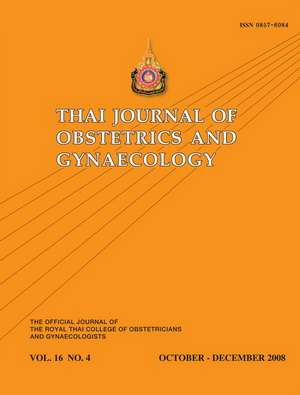Pregnancy Outcomes of Parturients with Excessiveweight in Maharat Nakorn Ratchasima Hospital
Main Article Content
Abstract
Objective: To compare the maternal and fetal adverse pregnancy outcomes in parturients
with excessive-weight and those with normal weight in Maharat Nakorn Ratchasima
Hospital.
Design: Retrospective analytic study.
Materials and Methods: Data was collected from medical records of 1350 pregnant women, who
attended the antenatal care clinic and delivered in Maharat Nakorn Ratchasima Hospital
during the first of October 2004 till 30th of September 2006. Body mass index was calculated
by using weight at pre-pregnancy period (kg), divided by height (m) squared. The subjects
were divided into two groups according to maternal BMI (normal group, BMI 20-24.99 and
excessive-weight group, BMI >25). Antenatal complications, intervention during labor, route
of delivery, maternal morbidity, birth weight and neonatal outcomes were collected and
analyzed.
Results: The prevalence of parturients with excessive weight was 16.18% (maternal
overweight (BMI 25-29.9) was 11.67% and maternal obesity (BMI >30) was 4.51%).
Compared to parturients with normal BMI, the following outcomes were significantly more
common in excessive-weight pregnant women (odds ratio (95% confidence interval)):
pre-eclampsia 6.99 (3.93-12.44), gestational diabetes mellitus 8.31 (3.22-21.42), preterm
delivery 1.53 (1.04-2.27), posterm delivery 1.70 (1.19-2.44), cesarean section 1.33 (1.01-
1.75), cephalopelvic disproportion 1.91 (1.32-2.77) and macrosomia 2.61 (1.19-5.74).
Conclusion: Parturients with excessive-weight had more significant adverse pregnancy
outcomes compared with those with normal weight.
with excessive-weight and those with normal weight in Maharat Nakorn Ratchasima
Hospital.
Design: Retrospective analytic study.
Materials and Methods: Data was collected from medical records of 1350 pregnant women, who
attended the antenatal care clinic and delivered in Maharat Nakorn Ratchasima Hospital
during the first of October 2004 till 30th of September 2006. Body mass index was calculated
by using weight at pre-pregnancy period (kg), divided by height (m) squared. The subjects
were divided into two groups according to maternal BMI (normal group, BMI 20-24.99 and
excessive-weight group, BMI >25). Antenatal complications, intervention during labor, route
of delivery, maternal morbidity, birth weight and neonatal outcomes were collected and
analyzed.
Results: The prevalence of parturients with excessive weight was 16.18% (maternal
overweight (BMI 25-29.9) was 11.67% and maternal obesity (BMI >30) was 4.51%).
Compared to parturients with normal BMI, the following outcomes were significantly more
common in excessive-weight pregnant women (odds ratio (95% confidence interval)):
pre-eclampsia 6.99 (3.93-12.44), gestational diabetes mellitus 8.31 (3.22-21.42), preterm
delivery 1.53 (1.04-2.27), posterm delivery 1.70 (1.19-2.44), cesarean section 1.33 (1.01-
1.75), cephalopelvic disproportion 1.91 (1.32-2.77) and macrosomia 2.61 (1.19-5.74).
Conclusion: Parturients with excessive-weight had more significant adverse pregnancy
outcomes compared with those with normal weight.
Article Details
How to Cite
(1)
Kitiyodom, S.; Tongswatwong, P. Pregnancy Outcomes of Parturients with Excessiveweight in Maharat Nakorn Ratchasima Hospital. Thai J Obstet Gynaecol 2017, 16, 214-220.
Section
Original Article


